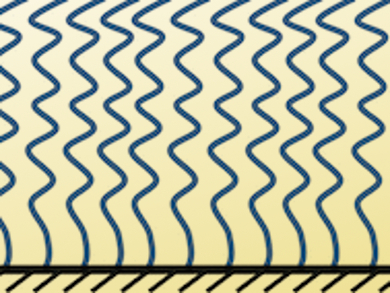Easy-to-Clean Surfaces
Surfaces that repel all dirt and graffiti, are easy to clean, and cause liquids to bead up and slide off (like the frequently mentioned lotus leaves), are high on the wish lists of engineers and scientists. However, none of the technologies developed in the past have been a sweeping success. In the journal Angewandte Chemie, American scientists have now introduced a new method for making transparent, dirt-repellant coatings that can be applied very quickly and easily. The coatings repel both water and oily liquids and are stable at higher pressures and temperatures.
Research into surfaces that repel liquids has been ongoing for decades. The first approaches involved coatings made with fluoropolymers (e.g. Teflon) and silicones. More recently, researchers attempted to mimic the micro- and nanostructured surfaces found in nature. However, liquids can still intrude into such surfaces at higher pressures, like when drops hit the surface at high speed. It is often nearly impossible to remove oily residues from the delicate surfaces. In addition, this type of surface is easy to scratch, and it is possible for microorganisms to grow on them. A third method, in which flexible chains are bound to a surface but act like a liquid, has proven very difficult to implement.
“Omniphobic” Coatings
Liming Wang and Thomas J. McCarthy at the University of Massachusetts (USA) have now developed a simple method for the production of such SOCAL surfaces (SOCAL = slippery, omniphobic, covalently attached liquid). Glass slides can be coated in minutes: just dip into a solution, dry, and rinse. The omniphobic coating repels any kind of liquid. The solution contains a siloxane monomer (Me2Si(OMe)2) and sulfuric acid in isopropanol. When an object is dipped into the liquid, a thin film of liquid forms on the surface and polymerizes as it dries. Catalyzed by the sulfuric acid, polydimethylsiloxane (PDMS) chains form and are firmly anchored to the surface. PDMS is a biocompatible silicone oil that is also used in medical applications.
The coating is very homogenous, which is very important for omniphobicity. Both aqueous and organic liquids roll off of coated slides without leaving a trace, even at a very minimal angle of inclination. The PDMS chains can move around as though in a liquid. Even the slightest movement in the chains is enough to remove all obstacles from the path of a rolling drop of liquid. Hexane rolls off at an incline of only 1 °, even though its surface tension is less than that of PDMS.
These new coatings are transparent, thermally stable, and robust. Their outstanding omniphobic properties are maintained even after a year in storage. The ease with which they can be produced should make application on an industrial scale practical.
- Covalently Attached Liquids: Instant Omniphobic Surfaces with Unprecedented Repellency,
Liming Wang, Thomas J. McCarthy,
Angew. Chem. Int. Ed. 2015.
DOI: 10.1002/anie.201509385




